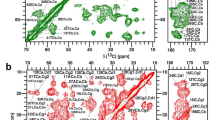Abstract
Asparagine-linked glycosylation is an essential and highly conserved protein modification reaction that occurs in the endoplasmic reticulum of cells during protein synthesis at the ribosome. In the central reaction, a pre-assembled high-mannose sugar is transferred from a lipid-linked donor substrate to the side-chain of an asparagine residue in an –N–X–T/S– sequence (where X is any residue except proline). This reaction is carried by a membrane-bound multi-subunit enzyme complex, oligosaccharyltransferase (OST). In humans, genetic defects in OST lead to a group of rare metabolic diseases collectively known as Congenital Disorders of Glycosylation. Certain mutations are lethal for all organisms. In yeast, the OST is composed of nine non-identical protein subunits. The functional enzyme complex contains eight subunits with either Ost3 or Ost6 at any given time. Ost4, an unusually small protein, plays a very important role in the stabilization of the OST complex. It bridges the catalytic subunit Stt3 with Ost3 (or Ost6) in the Stt3–Ost4–Ost3 (or Ost6) sub-complex. Mutation of any residue from M18-I24 in the trans-membrane helix of yeast Ost4 negatively impacts N-linked glycosylation and the growth of yeast. Indeed, mutation of valine23 to an aspartate impairs OST function in vivo resulting in a lethal phenotype in yeast. To understand the structural mechanism of Ost4 in the stabilization of the enzyme complex, we have initiated a detailed investigation of Ost4 and its functionally important mutant, Ost4V23D. Here, we report the backbone 1H, 13C, and 15N resonance assignments for Ost4 and Ost4V23D in dodecylphosphocholine micelles.



Similar content being viewed by others
References
Bai L, Wang T, Zhao G, Kovach A, Li H (2018) The atomic structure of a eukaryotic oligosaccharyltransferase complex. Nature 555:328–333. doi:https://doi.org/10.1038/nature25755
Chaudhary B, Mazumder S, Mohanty S (2017) Production and biophysical characterization of a mini-membrane protein, Ost4V23D: A functionally important mutant of yeast oligosaccharyltransferase subunit Ost4p. Protein Expr Purif 139:43–48. doi:https://doi.org/10.1016/j.pep.2017.07.009
Delaglio F, Grzesiek S, Vuister GW, Zhu G, Pfeifer J, Bax A (1995) NMRPipe: a multidimensional spectral processing system based on UNIX pipes. J Biomol NMR 6:277–293
Freeze HH (1998) Disorders in protein glycosylation and potential therapy: Tip of an iceberg? J Pediatr 133:593–600. doi:https://doi.org/10.1016/S0022-3476(98)70096-4
Gayen S, Kang C (2011) Solution structure of a human minimembrane protein Ost4, a subunit of the oligosaccharyltransferase complex. Biochem Biophys Res Commun 409:572–576. doi:https://doi.org/10.1016/j.bbrc.2011.05.050
Helenius A, Aebi M (2004) Roles of N-linked glycans in the endoplasmic reticulum. Annu Rev Biochem 73:1019–1049. doi:https://doi.org/10.1146/annurev.biochem.73.011303.073752
Huang C, Bhaskaran R, Mohanty S (2012) Eukaryotic N-glycosylation occurs via the membrane-anchored C-terminal domain of the Stt3p subunit of oligosaccharyltransferase. J Biol Chem 287:32450–32458. doi:https://doi.org/10.1074/jbc.M112.342253
Karaoglu D, Kelleher DJ, Gilmore R (1997) The highly conserved Stt3 protein is a subunit of the yeast oligosaccharyltransferase and forms a subcomplex with Ost3p and Ost4p. J Biol Chem 272:32513–32520
Kim H, Park H, Montalvo L, Lennarz WJ (2000) Studies on the role of the hydrophobic domain of Ost4p in interactions with other subunits of yeast oligosaccharyl transferase. Proc Natl Acad Sci USA 97:1516–1520. https://doi.org/10.1073/pnas.040556797
Kim H, Yan Q, Von Heijne G, Caputo GA, Lennarz WJ (2003) Determination of the membrane topology of Ost4p and its subunit interactions in the oligosaccharyltransferase complex in Saccharomyces cerevisiae. Proc Natl Acad Sci USA 100:7460–7464. https://doi.org/10.1073/pnas.1332735100
Kornfeld R, Kornfeld S (1985) Assembly of asparagine-linked oligosaccharides. Annu Rev Biochem 54:631–664. doi:https://doi.org/10.1146/annurev.bi.54.070185.003215
Kumar A, Ward P, Katre UV, Mohanty S (2012) A novel and simple method of production and biophysical characterization of a mini-membrane protein, Ost4p: a subunit of yeast oligosaccharyl transferase. Biopolymers 97:499–507. doi:https://doi.org/10.1002/bip.22028
Lee W, Tonelli M, Markley JL (2015) NMRFAM-SPARKY: enhanced software for biomolecular NMR spectroscopy. Bioinformatics 31:1325–1327. doi:https://doi.org/10.1093/bioinformatics/btu830
Marsh JA, Singh VK, Jia Z, Forman-Kay JD (2006) Sensitivity of secondary structure propensities to sequence differences between alpha- and gamma-synuclein: implications for fibrillation. Prot Sci 15:2795–2804
Marshall RD (1972) Glycoproteins. Annu Rev Biochem 41:673–702. https://doi.org/10.1146/annurev.bi.41.070172.003325
Shen Y, Delaglio F, Cornilescu G, Bax A (2009) TALOS+: a hybrid method for predicting protein backbone torsion angles from NMR chemical shifts. J Biomol NMR 44:213–223. doi:https://doi.org/10.1007/s10858-009-9333-z
Westphal V, Xiao M, Kwok PY, Freeze HH (2003) Identification of a frequent variant in ALG6, the cause of Congenital Disorder of Glycosylation-Ic. Hum Mutat 22:420–421. doi:https://doi.org/10.1002/humu.9195
Wild R, Kowal J, Eyring J, Ngwa EM, Aebi M, Locher KP (2018) Structure of the yeast oligosaccharyltransferase complex gives insight into eukaryotic N-glycosylation. Science 359:545–550. https://doi.org/10.1126/science.aar5140
Zubkov S, Lennarz WJ, Mohanty S (2004) Structural basis for the function of a minimembrane protein subunit of yeast oligosaccharyltransferase. Proc Natl Acad Sci USA 101:3821–3826. https://doi.org/10.1073/pnas.0400512101
Acknowledgements
This work was financially supported by National Science Foundation Award CHE-1807722 and DBI-1726397 to SM. A portion of this work was performed at the National High Magnetic Field Laboratory, Tallahassee, FL, which is supported by NSF Cooperative Agreement No. DMR-1644779 and the State of Florida. We thank Dr. Chengdong Huang for recording some of the Ost4 NMR data for us. We thank Dr. Thomas Webb of Auburn University, Auburn, AL for the critical reading of the manuscript. We thank Ms. Ishani Ray for help with proofreading of the manuscript.
Author information
Authors and Affiliations
Contributions
SM conceived, designed the strategies and techniques employed, supervised the research, and analyzed the data. BC expressed, purified and reconstituted both recombinant proteins, performed all NMR experiments, and processed NMR data. BC and DZ analyzed and completed the backbone and side-chain resonance assignments. SM and BC wrote the paper and BC prepared the figures.
Corresponding author
Ethics declarations
Conflict of interest
The authors declare that they have no conflict of interest with the contents of this article.
Additional information
Publisher's Note
Springer Nature remains neutral with regard to jurisdictional claims in published maps and institutional affiliations.
Rights and permissions
About this article
Cite this article
Chaudhary, B.P., Zoetewey, D. & Mohanty, S. 1H, 13C, 15N resonance assignments and secondary structure of yeast oligosaccharyltransferase subunit Ost4 and its functionally important mutant Ost4V23D. Biomol NMR Assign 14, 205–209 (2020). https://doi.org/10.1007/s12104-020-09946-7
Received:
Accepted:
Published:
Issue Date:
DOI: https://doi.org/10.1007/s12104-020-09946-7




